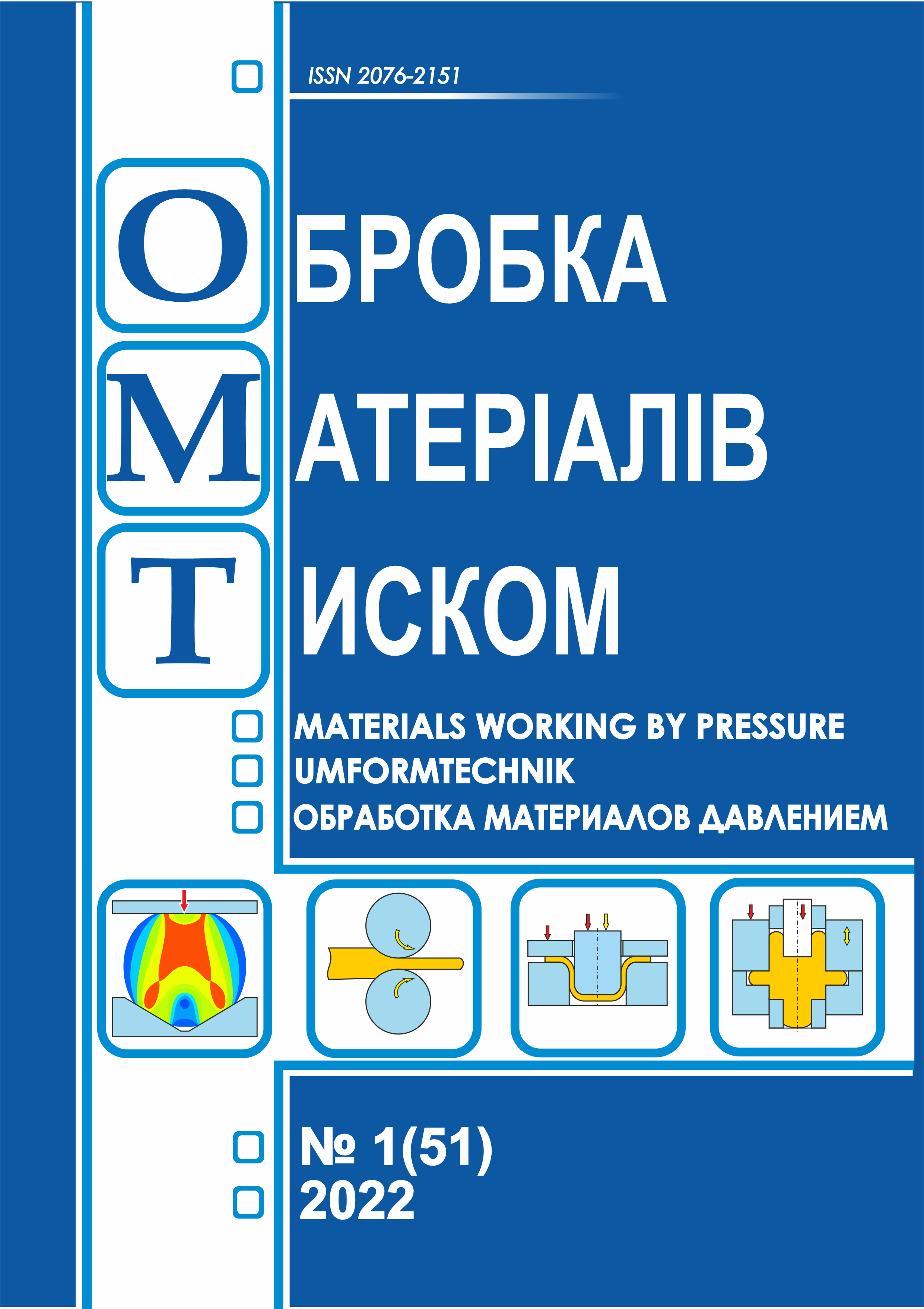high pressure torsion, hollow billet, plant, monitoring, automated control system
DOI:
https://doi.org/10.37142/2076-2151/2022-1(51)177Keywords:
high pressure torsion, hollow billet, plant, monitoring, automated control systemAbstract
Tarasov O. F., Kasyanyuk O. S., Gribkov E. P., Babash A. V., Kovalenko A. K. Design of the experimental plant control system for the process of torsion under high pressure of hollow blanks
The development of industrial enterprises and the introduction of Internet of Things technology in production require the creation of new mechanisms, the development of which requires the use of modern components followed by precise computer control of the process. In the field of pressure metal processing, high pressure torsion (HPT) machines can be considered such mechanisms, since this process is gaining popularity due to obtaining a submicroscopic structure in the workpiece and extremely high strength of the material as a result of processing. At the same time, the use of HPT installations has significant limitations, which are determined by a significant number of parameters that can change non-linearly during the deformation process. Installation management problems are solved thanks to the use of automated control systems (ACS) for technological process parameters. The article presents the essence of a new process of hollow blanks deformation using torsion under high pressure. A description of the experimental setup and the controls used is given. This technological process is represented by a set of events and activities, the connection between which is displayed in the form of a cyclogram. On the basis of the analysis of the presented technological process, a system of monitoring and ACS of the installation was developed. A logic diagram of the ACS, a diagram of determining the composition of the ACS installation for the implementation of the HPT technology and a components diagram of its software complex have been developed. A schematic solution for using a frequency converter to set the torsion mechanism in motion is presented. An incremental encoder from Siemens and an STM32F4Discovery debugging board were used to accurately count the rotations number of the torsion mechanism. The use of a frequency electric drive made it possible to increase the efficiency of the installation control. The development and use of similar ACS for other pressure metal processing installations will guarantee a stable technological process and the necessary physical properties of the workpieces.
References
Segal V. Review: Modes and processes of severe plastic deformation (SPD). Materials. 2018. 11(7): 1175, pp. 1–29. DOI: https://doi.org/10.3390/ma11071175
Li Y., Lu Z., Li T., Li D., Lu J., Liaw P. K., Zou, Y. Effects of surface severe plastic deformation on the mechanical behavior of 304 stainless steel. Metals. 2020. 10(6), pp. 1–13. DOI: https://doi.org/doi:10.3390/met10060831
Edalati K., Horita Z. A Review on High-Pressure Torsion (HPT) from 1935 to 1988. Materials Science and Engineering A. 2016. 652. pp.325-352. DOI: https://doi.org/10.1016/j.msea.2015.11.074
Silva C., Montoro L. A., Martins D. A. A. et al. Interface structures in Al-Nb2O5 nanocomposites processed by high-pressure torsion at room temperature. Materials Characterization, 2020. 162: 110222, pp. 1–9. DOI: https://doi.org/10.1016/j.matchar.2020.110222
Kawasaki M., Langdon T. G. Review: achieving superplasticity in metals processed by high-pressure torsion. Journal of Materials Science. 2014. 49(19). pp. 6487–6496. DOI: https://doi.org/10.1007/s10853-014-8204-5
Akbarpour M. R., Mirabad H. M., Alipour S., Kim H. S. Enhanced tensile properties and electrical conductivity of Cu-CNT nanocomposites processed via the combination of flake powder metallurgy and high pressure torsion methods. Materials Science and Engineering: A. 2019. 773: 138888, pp. 1–10. DOI: https://doi.org/10.1016/j.msea.2019.138888
Bartkowska A., Bazarnik P., Huang Y., Lewandowska M., Langdon T. G. Using high-pressure torsion to fabricate an Al–Ti hybrid system with exceptional mechanical properties. Materials Science and Engineering: A. 2021. 799: 140114. pp. 1–5. DOI: https://doi.org/10.1016/j.msea.2020.140114
Edalati P., Floriano R., Tang Y. et al. Ultrahigh hardness and biocompatibility of high-entropy alloy TiAlFeCoNi processed by high-pressure torsion. Materials Science and Engineering: C. 2020. 112: 110908. pp. 1–10 DOI: https://doi.org/10.1016/j.msec.2020.110908
Kvashnin V.O., Babash A.V., Kvashnin V.V. Programming and application of STM32F4Discovery microcontrollers: monograph. Kramatorsk: CTRI "Printing House". 2017. 143 p. 978-6177415-30-4 (in Ukrainian).
Henderson K., Salado A. Value and benefits of model‐based systems engineering (MBSE): Evidence from the literature. Systems Engineering. 2021. 24(1). pp. 51–66. DOI: https://doi.org/10.1002/sys.21566
Kumar A., Dhanwate S. SysML Based Modelling of Gear Shifting Strategy and Drivability for Automatic Transmission. Journal of Physics Conference Series. 2020. 1478: 012008. pp. 1–9. DOI: https://doi.org/10.1088/1742-6596/1478/1/012008
Munk P., Nordmann A. Model-based safety assessment with SysML and component fault trees: application and lessons learned. Softw Syst Model. 2020. 19. pp. 889–910. DOI: https://doi.org/10.1007/s10270-020-00782-w
Yoo S., Lee S., Kim S. et al. Integrating deep learning into CAD/CAE system: generative design and evaluation of 3D conceptual wheel. Struct Multidisc Optim. 2021. 64. pp. 2725–2747. DOI: https://doi.org/10.1007/s00158-021-02953-9
Yuan W.-H., Wang H.-C., Zhang W., Dai B.-B., Liu K., Wang Y. Particle finite element method implementation for large deformation analysis using Abaqus. Acta Geotechnica. 2021. 16(8). pp. 2449–2462. DOI:https://doi.org/10.1007/s11440-020-01124-2
Babash A.V., Kvashnin V.O., Tarasov A.F., Gribkov E.P. Implementation of the intensive plastic deformation process using a modern complete electric drive. Modern problems and achievements in the field of radio engineering, telecommunications and information technologies : materials of the IX International Scientific and Practical Conference. October 3–5, 2018. Zaporizhzhia: ZNTU. 2018. pp. 168-170 (in Ukrainian).
Kazachkovskii N.N., Yakupov D.V. Altivar 31 frequency converter programming: Methodical materials for advanced training courses and students of specialty 7.092203 "Electromechanical systems of automation and electric drive". Dnipropetrovsk: educational center of the company "Schneider Electric". 2006. 45 p. (in Russian).

